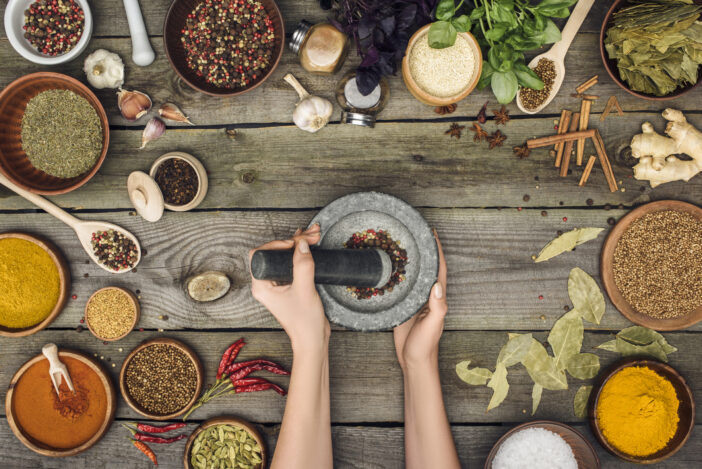7 Natural Spices for Cooking to Boost Your Flavor Skills
Enhance dishes with natural spices by choosing wisely, toasting and grinding for freshness, balancing flavors, timing additions, and proper storage.

Unlock the full potential of your kitchen with natural spices that elevate every dish. Discover simple yet powerful tips to transform your cooking into a flavorful adventure.
Disclosure: As an Amazon Associate, this site earns from qualifying purchases. Thank you!
Choosing the Right Natural Spices

Selecting the best natural spices enhances your dishes’ flavors and makes cooking a delightful experience.
Consider the Cuisine
Match your spices to the cuisine you’re preparing. Use cumin, coriander, and turmeric for Indian dishes. Go for basil, oregano, and rosemary in Italian recipes. Incorporate cardamom, cinnamon, and cloves in Middle Eastern fare. Keep your spice rack varied to handle multiple cuisines effectively.
Seasonal Availability and Freshness
Opt for spices that are in season for the best flavor. Fresh spices have more potent aromas and richer tastes. Buy whole spices and grind them yourself to maintain freshness longer. Check the harvest dates to ensure you’re getting fresh products.
Preparing Natural Spices for Cooking

Mastering the art of preparing natural spices can significantly elevate your dishes. Here’s how to get the most out of your spices:
Toasting Spices to Enhance Flavor
- Heat whole spices in a dry skillet over medium heat until fragrant, about 2-3 minutes.
- Stir continuously to avoid burning, ensuring even toasting.
- Transfer to a cool plate immediately to stop cooking, preserving the enhanced flavors.
Grinding Spices for Freshness
- Use a spice grinder or mortar and pestle to grind whole spices just before cooking.
- Grind in small batches to maintain potency and aroma.
- Store ground spices in airtight containers, away from light and heat, for optimal freshness.
Incorporating Spices into Your Cooking

Balancing Flavors
- Pair spices thoughtfully. Use contrasting spices to add depth—think sweet cinnamon with spicy cayenne. Balance strong spices like cumin with lighter ones like coriander.
- Create harmony. Mix earthy spices like turmeric with acidic ingredients like lemon juice. It creates a balanced taste profile.
- Taste as you go. Adjust levels little by little. Small tweaks can shift your dish from bland to brilliant.
Timing Your Spice Additions
- Add spices early. Let spices like bay leaves and cinnamon simmer in sauces to unlock flavors.
- Incorporate late spices. Add delicate herbs like basil or parsley at the end to retain freshness.
- Layer flavors. Add spices at different cooking stages. Start with seeds in oil and end with ground spices for complexity.
Storing Natural Spices to Maintain Potency

Proper storage is crucial for retaining the flavor and potency of natural spices.
Ideal Storage Conditions
- Keep Them Cool: Store spices in a cool, dark place away from direct sunlight and heat sources. Heat and light can degrade the quality quickly.
- Use Airtight Containers: Use airtight containers made of glass or high-quality plastic to prevent air and moisture from getting in.
- Avoid Humidity: Keep spices away from moisture. Humidity can cause spices to clump and lose their potency. Utilize desiccant packs for extra protection.
| Spice | Shelf Life (Whole) | Shelf Life (Ground) |
|---|---|---|
| Black Pepper | 4 years | 2 years |
| Cinnamon | 3 years | 1 year |
| Cumin | 4 years | 2 years |
| Paprika | 3 years | 2 years |
| Turmeric | 3-4 years | 2-3 years |
Replace spices that have lost their vibrant color and aroma. Fresh spices enhance dishes more effectively.
Advanced Tips for Using Natural Spices
Boost your culinary skills with these advanced techniques for using natural spices effectively.
Layering Spices for Complexity
- Start with base flavors. Add spices like cumin and coriander at the beginning to build a strong foundation.
- Incorporate mid-cooking layers. Sprinkle in spices like paprika or turmeric midway to create depth.
- Finish strong. Use fresh herbs, such as cilantro or dill, towards the end for a burst of freshness.
Pairing Spices with Ingredients
- Understand flavor profiles. Pairing cinnamon with apples creates a warm, sweet dish.
- Balance heat and sweetness. Combine chili powder with honey for well-rounded sauces.
- Complement proteins. Match rosemary with lamb or thyme with chicken to enhance natural flavors.
Frequently Asked Questions
How can natural spices enhance the flavor of dishes?
Natural spices can elevate flavors by adding depth, complexity, and richness to dishes. They also enhance the cooking experience by allowing customization of taste profiles.
What should you consider when choosing natural spices?
When selecting spices, consider the cuisine, seasonal availability, freshness, and proper preparation techniques to ensure the best flavor and quality.
How do you balance flavors with spices?
Balance flavors by thoughtfully choosing complementary spices, adjusting taste levels gradually, and carefully considering sweetness, heat, and other taste elements.
When should spices be added during cooking?
Add spices early for simmering to develop deep flavors and later for retaining freshness. Layer spices at different cooking stages to create a more complex taste.
How do you layer spices for complexity?
Start with base flavors, incorporate mid-cooking layers, and finish with fresh herbs to add complexity and depth to your dishes.
What is important when pairing spices with ingredients?
Understand the flavor profiles, balance heat and sweetness, and complement proteins to enhance the natural flavors of the ingredients used.






